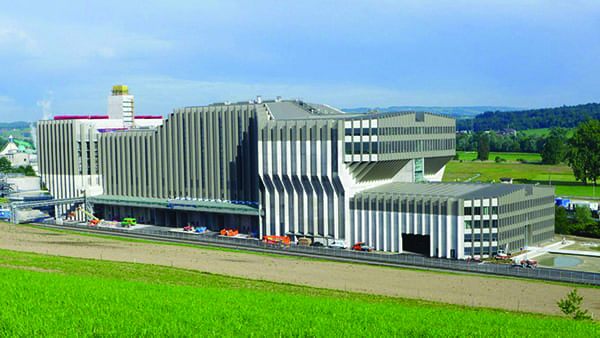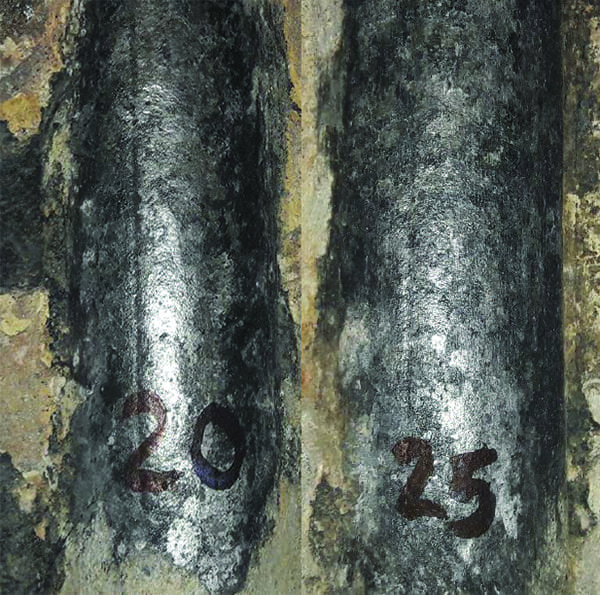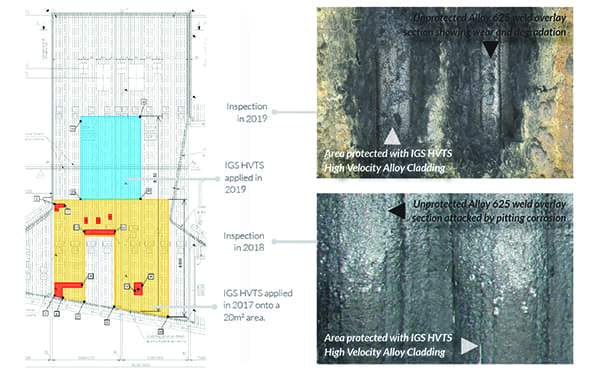HVTS Stops Alloy 625 Weld Overlay Corrosion in Waste-to-Energy Boiler
The post HVTS Stops Alloy 625 Weld Overlay Corrosion in Waste-to-Energy Boiler appeared first on POWER Magazine.

A boiler at the Renergia waste incineration plant in Perlen, Switzerland, was experiencing fireside corrosion. The shop-applied Alloy 625 weld overlay was showing signs of premature accelerated degradation.
 |
1. The Renergia Zentralschweiz AG plant supplies process steam to Perlen Papier AG, and district heating networks Rontal and Emmen with hot water. It also provides electricity for several thousand homes in the area in Switzerland. Courtesy: Integrated Global Services (IGS) |
The operators of the waste-to-energy (WtE) boiler were looking for a solution to stop the corrosion and ensure the reliable and safe operation of the boiler, and looked at several options. Maintaining operation of the facility was critical, because the Renergia Zentralschweiz AG plant (Figure 1)-a joint effort of all waste disposal associations from central Switzerland and Perlen Papier AG-is responsible for more than just recycling waste. The plant, in operation since 2015, supplies Perlen Papier AG with process steam. It also supplies the district heating networks Rontal and Emmen with hot water, and provides electricity for about 44,000 homes.
WtE Boiler Fireside CorrosionThe Hitachi Zosen Inova (HZI) furnace installed at Renergia is an inclined moving grate four-pass WtE boiler with an external economizer. The boiler's thermal capacity is 47 MW, with steam flow of 58 metric tons per hour and steam pressure of 41 bar at 410C.
Alloy 625 weld overlay was shop-applied on the fireside waterwall panels to protect the WtE boiler tubes from fireside corrosion. After months of operation, an inspection revealed accelerated degradation of the Alloy 625 just above the grate.
Several solutions were considered to manage the boiler tube metal wastage, and improve reliability and lifetime of the waterwalls, including replacement, field-applied weld overlay, and high-velocity thermal spray (HVTS).
Evaluation of AlternativesThe replacement of affected waterwall sections with new tubes would have been time-consuming and expensive, considering the estimated frequency of replacement of five years or less. Like-for-like weld overlay repair (Figure 2) is an intensive and lengthy process, requiring preliminary grinding of the degraded surface layer prior to the application of new weld overlay. Moreover, both of those solutions-installing new tubes or a weld overlay-wouldn't exactly solve the problem, as the same corrosive media attacking existing weld overlay would still be present.
 |
2. Like-for-like weld overlay repair is an intensive process. It is designed to protect the boiler tubes, in this case in a waste-to-energy (WtE) boiler, from fireside corrosion. It requires preliminary grinding of the degraded surface layer prior to the application of new weld overlay. It provides protection, but does not solve the problem of corrosive media continuing to attack the weld overlay. Courtesy: IGS |
The third option was thermal spray. The technology had mixed results in boiler applications and the plant invited four thermal spray vendors to perform test applications on different sections within the boiler. Each vendor was given a side wall inside the two lines. Out of the four claddings applied, only two delivered satisfactory results. Integrated Global Services (IGS) HVTS solution was found to be superior, both in terms of performance and capacity. Multiple IGS HVTS guns can be operated inside the boiler at the same time with no capacity limitations.
Supported by comprehensive laboratory testing and extensive field experience, IGS HVTS Alloy Cladding has no issues with permeability or disbondment and can offer lasting protection, where other technologies fall short. The test application results and additional references convinced the head of maintenance to choose IGS HVTS as the solution to the plant's problem.
HVTS ApplicationIGS HVTS application took place in 2017 on a 20-square-meter (m2) area located on the left membrane wall, at the very low furnace of the moving grate WtE boiler above the refractory. The plant also had a thermal spray coating applied by a different vendor on the right-hand side of the membrane.
 |
3. This illustration shows the sequence of high-velocity alloy cladding applications and inspections from 2017 to 2019 at the Renergia WtE plant in Switzerland. The photos show the difference between the areas in the boiler protected with high-velocity thermal spray (HVTS) versus the unprotected areas. Courtesy: IGS |
These areas were then inspected in 2018 to determine whether HVTS and another vendor's thermal spray were successful at stopping the weld-metal overlay (WMO) degradation. The inspection of the HVTS/WMO interface showed that the area clad with IGS HVTS was no longer affected by corrosion (Figure 3). Unprotected Alloy 625 WMO and the other vendor's thermal spray, though, both continued to degrade.
It was decided to extend the scope and apply HVTS alloy cladding onto an additional ~20 m2 area in 2019. Inspection later that year, in August, confirmed the following: the areas protected with HVTS alloy cladding were not exhibiting any pitting corrosion or wastage. Adjacent unprotected Alloy 625 weld overlay sections were showing signs of wear and degradation.
Weld Overlay Protection: Inspection and ResultsMarkus Benz, head of maintenance at Renergia Zentralschweiz AG, said, IGS Europe s.r.o. has been selected in November 2017 to apply ~20 m2 of their IGS material using their HVTS technology. They mobilized efficiently and performed within the tight requested schedule the expected scope of work.
After 10 months in operation, a short inspection of the waste-to-energy boiler was performed in September 2018 confirming the good performance of the coating," said Benz. As a result, another area was ordered for application in January 2019, with a deeper inspection confirming the good overall behavior of the cladding after 14 months in operation."
Benz continued: The protected area has been doubled so that we expect to operate safely until our next turnaround in 18 months. IGS has successfully applied the contracted scope within the critical path in a highly professional manner, with reliable and transparent communication."
Ruedi Kummer, director of Renergia Zentralschweiz AG, was complementary of the process. He commented: Thank you for the inspection review. It seems that the idea, to cover Alloy 625 with HVTS overlay, could have enormous potential."
-Marina Silvais international marketing manager for Integrated Global Services.
The post HVTS Stops Alloy 625 Weld Overlay Corrosion in Waste-to-Energy Boiler appeared first on POWER Magazine.